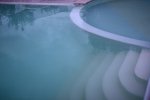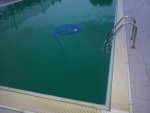Hi, new to this forum and in need of help. Our pool is 4 years old, and each year it has been a bit of an experiment getting it going for the summer.
We are in Southern Italy and much of what is talked about here is like a foreign language to me. Our pool is 8 metres by 25 metres, with a .8 metre shallow end and an 2.8 metre deep end. There is no "shelf" the gradient is constant. It is in infinity type pool, and so does not have conventional skimmers. There is also a 40,000 litre "holding tank" for the overflow.
We shocked the pool about 4 weeks ago with 50 kilos of dichlor, and followed up a week later with another 20 kilos. When we first put the 50 kilos in a few hours later the pool surface looked like a frozen lake, which we skimmed off, filtered overnight, and then backwashed. The 20 kilos later seemed to clear the pool, although it was dirty at the bottom.
Last week we tried to clean the bottom of the pool, which stirred everything up and gave us very murky water, which has subsequently gone a very bright almost flourescent green. I checked the chlorine level this morning and it is about 1.5, and the PH is around 72/73.
Help!!
After reading this article turning-your-green-swamp-back-into-a-sparkling-oasis-t4147.html it seems our mistake was not clearing the bottom of the pool during shocking, does that sound right?
We are in Southern Italy and much of what is talked about here is like a foreign language to me. Our pool is 8 metres by 25 metres, with a .8 metre shallow end and an 2.8 metre deep end. There is no "shelf" the gradient is constant. It is in infinity type pool, and so does not have conventional skimmers. There is also a 40,000 litre "holding tank" for the overflow.
We shocked the pool about 4 weeks ago with 50 kilos of dichlor, and followed up a week later with another 20 kilos. When we first put the 50 kilos in a few hours later the pool surface looked like a frozen lake, which we skimmed off, filtered overnight, and then backwashed. The 20 kilos later seemed to clear the pool, although it was dirty at the bottom.
Last week we tried to clean the bottom of the pool, which stirred everything up and gave us very murky water, which has subsequently gone a very bright almost flourescent green. I checked the chlorine level this morning and it is about 1.5, and the PH is around 72/73.
Help!!
After reading this article turning-your-green-swamp-back-into-a-sparkling-oasis-t4147.html it seems our mistake was not clearing the bottom of the pool during shocking, does that sound right?




